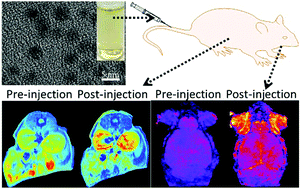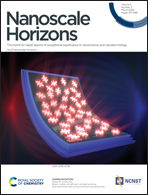Single-layer boron-doped graphene quantum dots for contrast-enhanced in vivo T1-weighted MRI†
Abstract
Gadolinium (Gd)-based chelates are used as clinical T1 contrast agents for magnetic resonance imaging (MRI) due to their demonstrated high sensitivity and positive contrast enhancement capability. However, there has been an increasing safety concern about their use in medicine because of the toxicity of the metal ions released from these contrast agents when used in vivo. Although significant effort has been made in developing metal-free MRI contrast agents, none have matched the magnetic properties achieved by the gold standard clinical contrast agent, Gd diethylene penta-acetic acid (Gd-DTPA). Here, we report the development of a single-layer, boron-doped graphene quantum dot (termed SL-BGQD) that demonstrates better T1 contrast enhancement than Gd-DTPA. The SL-BGQD is shown to provide significantly higher positive contrast enhancement than the Gd-DTPA contrast agent in imaging vital organs, including kidneys, liver, and spleen, and especially, vasculatures. Further, our results show that the SL-BQGD is able to bypass the blood–brain barrier and allows sustained imaging for at least one hour with a single injection. Hematological and histopathological analyses show that the SL-BGQD demonstrates a non-toxic profile in wild-type mice and may, therefore, serve as an improved, safer alternative to currently available clinical MRI contrast agents.



 Please wait while we load your content...
Please wait while we load your content...